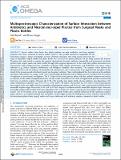Please use this identifier to cite or link to this item:
http://hdl.handle.net/11547/11386| Title: | Dynamical behavior of one rational fifth-order difference equation |
| Authors: | Saygın, Hasan |
| Issue Date: | 2023 |
| Series/Report no.: | 15;1 |
| Abstract: | Recent studies have shown that plastic particles can sorb antibiotics, and these sorption properties have been examined in various studies; however, the possible mechanism responsible for the interactions requires a deeper investigation in terms of further interaction with living systems. Moreover, the usage of disposable surgical masks and plastic bottles has increased the plastic pollution risk for living systems like humans. Therefore, this study aimed to examine the sorption characteristics between antibiotics (amoxicillin and spiramycin) and plastic particles from surgical masks and plastic bottles through batch sorption experiments. In the study, their surface interactions were characterized using multispectroscopic approaches including FTIR, Raman spectrometry, and SEM-EDX, and various surface indicators (e.g., surface oxidation, deformation, and biological potential) were examined. The sorption results showed that adsorption kinetics and the isotherm of amoxicillin and spiramycin on micro(nano)plastics from surgical masks and plastic bottles closely fit the pseudo-second-order kinetic model and Langmiur isotherm. These results indicated that the evidence for the antibiotic interaction with particles was changes in the surface functional group intensities and up-shifting, and this correlated with the sorption of antibiotics on micro(nano)-sized plastics. The C/N ratio of the plastic particles before and after antibiotic treatment was used as an indicator for the surface biological interaction, and the results showed that C/N ratios of surgical mask particles increased with both types of antibiotic sorption. However, the C/N of the particles from plastic bottles showed antibiotic type-dependence. The surface deformation indicators (e.g., O/C, C=O, C=C, and O-H indices) showed that the O/C ratios of micro(nano)plastics from surgical masks were higher with the amoxicillin and spiramycin sorption, and the C=O indices were positively linked with the amoxicillin sorption stages, whereas the C=C and O-H had a negative correlation with the amoxicillin sorption stages. Moreover, amoxicillin sorption influenced the O/C ratio and indices of O-H and C=C of micro(nano)plastics from plastic bottles in a limited manner. The C=O groups of the micro(nano)plastics from plastic bottles were positively influenced by the spiramycin sorption stages, whereas it was negatively linked with amoxicillin sorption stages. Overall, the findings from surface indicators indicated that the micro(nano)plastics from surgical masks can be more influenced with antibiotic sorption compared to plastic bottles. |
| URI: | http://hdl.handle.net/11547/11386 |
| ISSN: | 2075-9827 2313-0210 |
| Appears in Collections: | Web Of Science |
Files in This Item:
| File | Description | Size | Format | |
|---|---|---|---|---|
| baysal-saygin-2023-multispectroscopic-characterization-of-surface-interaction-between-antibiotics-and-micro(nano)-sized.pdf | 3.77 MB | Adobe PDF |  View/Open |
Items in DSpace are protected by copyright, with all rights reserved, unless otherwise indicated.
